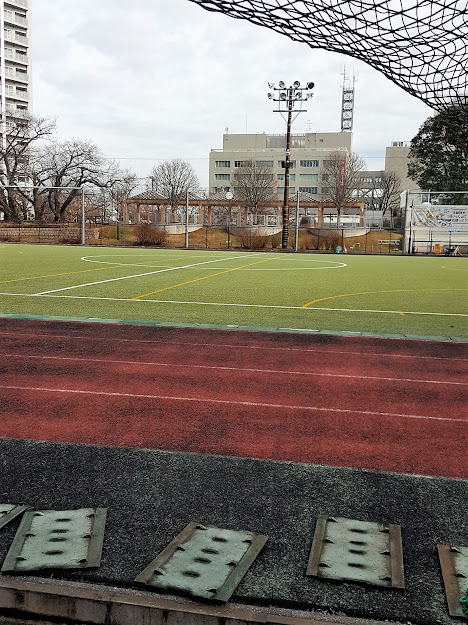OVERVIEW
In Japan, sports are being integrated into
people’s lives from very young ages, starting off with the early educational
stages, and maintain a deep social and cultural significance in time. Physical
education here comprises of both practical sessions and theory. Traditional
sports are still widely practiced, while modern, imported sports are increasingly
popular, whether it is watching or playing. Tournaments, sports days, and other
competitions are generally held throughout the year and include a variety of
sports. Many children engage in physical activity outside of schools as well,
practicing before and / or after classes. [1]
FACILITIES
Here, it is the norm for schooling institutions
to be equipped with pools, basketball courts, volleyball courts, gyms, etc.
From our conversation with Sakai Yoshiyuki, Kokugakuin Kugayama High School [2]
basketball coach, it is not just Tokyo or other big cities that benefit from
such equipment – these are present all over Japan. As mentioned above, besides
schools, sports activities are generally a popular choice among Japanese people
of all ages during their spare time. Free or at a reasonable price, depending
on the activity, with discounts for kids of up to 50% in most cases, Japanese
people have broad access to parks and plenty of sports facilities like ice
skating rinks, roller skating rinks, bouldering, tennis courts, surfing, etc. [3]
[4]
[5] [6] [7]
POPULAR CHOICES
Although Japanese people tend to show interest
in a wide variety of sports and popularity is not a main factor, there are
still, however, some popular choices which may differ somewhat in accordance to
each season. Baseball, football, and volleyball, as well as swimming during summer
are most frequently practiced in schools. On a wider scale, considering the society
as a whole, baseball, followed by soccer, were the most favoured sports for two
years consecutively – in 2018 and 2019. The types of physical activities that
people most often engage in, overall, are “walking or light physical exercise,
training with gym equipment, bowling, or jogging and marathon”. [1]
PARTICIPATION STATISTICS
With such exposure to sporting activities, it
becomes evident why so many people maintain an active lifestyle, and even more,
develop a passion for certain sports that they choose to pursue professionally.
Studies reveal that sports participation rate of people aged ten and above
reached about 68.8% in 2016, having increased with 5.8% compared to a year
before. [1]
Even more, in 2019 approximately 45.5% of children (4-11 years old) have been
engaging in sports activities at least seven times a week. Contrastingly, only
3% of children have mentioned not exercising at all throughout the timeframe of
the research. [8]
Participation in sports is also rather high among people with disabilities – in
2016 about 40% having been engaging in sports. [9]
BACKGROUND AND EXPLANATIONS
As mentioned in our previous article with Yutaka Saho, CEO
of Sports Safety Japan, [10]
the country will face an ageing population and declining birthrate, all of
which impact the state of society, culture, and economy. Such implications
explain why Japanese people increasingly emphasize sports and healthy
lifestyles. Therefore, after a decrease in sports participation during the past
two decades, an upward trend is clearly evident in recent years. [11]
Accordingly, in order to prevent the negative
implications of the above-mentioned trends, the Ministry of Education, Culture,
Sports, Science and Technology (MEXT) and the Japan Sports Agency (JSA) have
allocated a budget of 32.4 billion JPY in 2016, increasing from 29 billion JPY
in 2015. Moreover, in 2016, schools’ physical education system accounted for
16.1% of the government total sports budget in Japan, a substantial raise from only
1.8% in 2007. [12]
[13]
OUTCOMES
As a result, the way in which sports are emphasised
nowadays in Japan is clearly a noticeable element of people’s mindsets,
lifestyles, and culture. Among many other measures, the embedding of sports
into everyday life is a way in which society is preparing for the upcoming socio-cultural
changes, proving a health-driven approach and a long-term oriented philosophy that
further generations could also benefit from. This conclusion could also be demonstrated
through Hofstede Insights ‘long-term orientation’ dimension, describing how a
society maintains a connection to its past while adapting to the challenges of
the present and future. With a score of 88, Japan is among the most long-term oriented
countries in the world. [14]
REFERENCE LIST
Best
Living Japan (n.d.) City Wave Tokyo (Shinagawa, Tokyo) [online]
available from https://bestlivingjapan.com/city-wave-tokyo-shinagawa/
Best
Living Japan (n.d.) Tokyo Dome Rollerskating, Kōrakuen – Enjoy Family
Skating [online] available from https://bestlivingjapan.com/tokyo-dome-rollerskating/
Culture
Trip (2017) Where to Go Ice Skating in Tokyo [online] available from https://theculturetrip.com/asia/japan/articles/where-to-go-ice-skating-in-tokyo/
Hofstede
Insights (2020) WHAT ABOUT JAPAN? [online] available from https://www.hofstede-insights.com/country-comparison/japan/
Kokugakuin
Kugayama Junior High School (2020) News / Topics [online] available from
https://www.kugayama-h.ed.jp/#TOP
Sports
Safety Japan (2019) WHAT IS SPORTS SAFETY? [online] available from http://www.sports-safety.com/
Statista
(2016) Annual government sports budget in Japan from 2007 to 2016 [online] available from https://www.statista.com/statistics/933140/japan-sports-budget-government/
Statista
(2016) Share of annual government sports budget for physical education at
school in Japan from 2007 to 2016 [online] available from https://www.statista.com/statistics/933445/japan-sports-budget-government-physical-education-school-share/
Statista
(2016) Sport participation rate of people with disabilities in Japan in
2016, by frequency [online] available from https://www.statista.com/statistics/922378/japan-sports-participation-rate-people-with-disabilities-by-frequency/
Statista
(2019) Favorite sports among people in Japan as of September 2019
[online] available from https://www.statista.com/statistics/793381/japan-favorite-sports/
Statista
(2019) Sport participation rate among children in Japan as of 2019, by
frequency [online] available from https://www.statista.com/statistics/922459/japan-participation-rate-children-playing-sports-by-frequency/
Statista
(2019) Sports in Japan - Statistics & Facts [online] available from https://www.statista.com/topics/4986/sports-in-japan/
Time
Out Tokyo (2018) Best bouldering gyms in Tokyo [online] available from https://www.timeout.com/tokyo/sport-and-fitness/best-bouldering-gyms
Tokyo
Cheapo (2019) Where to Play Tennis in Tokyo [online] available from https://tokyocheapo.com/living/tokyo-tennis-courts/









Comments
Post a Comment